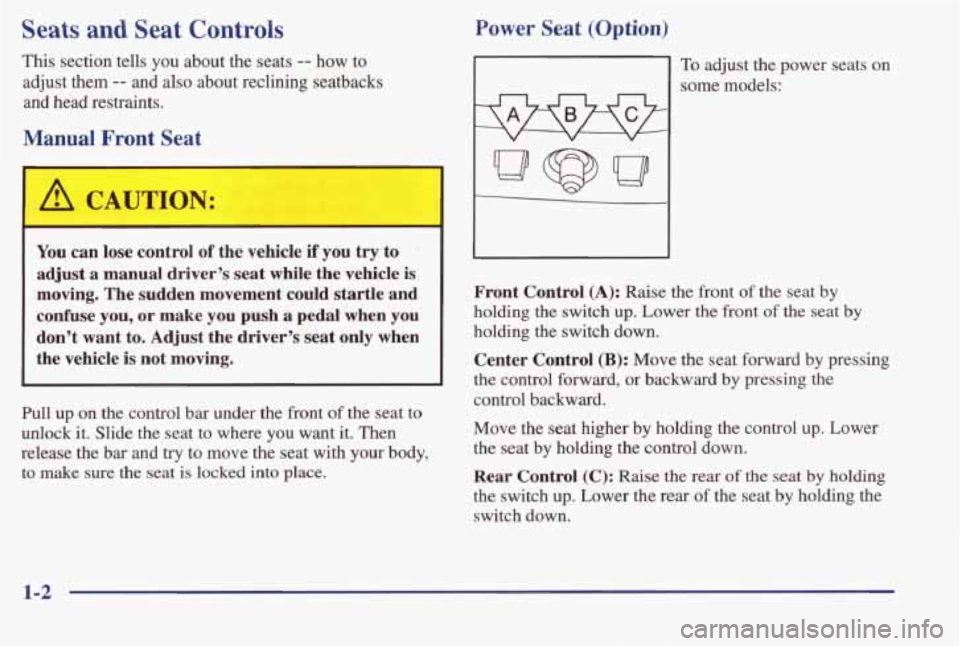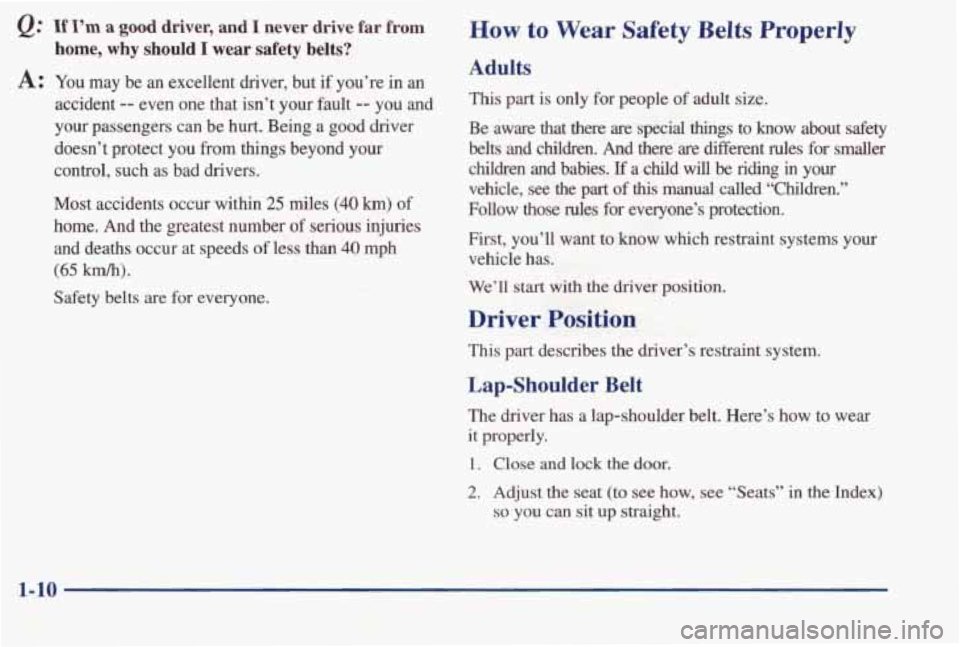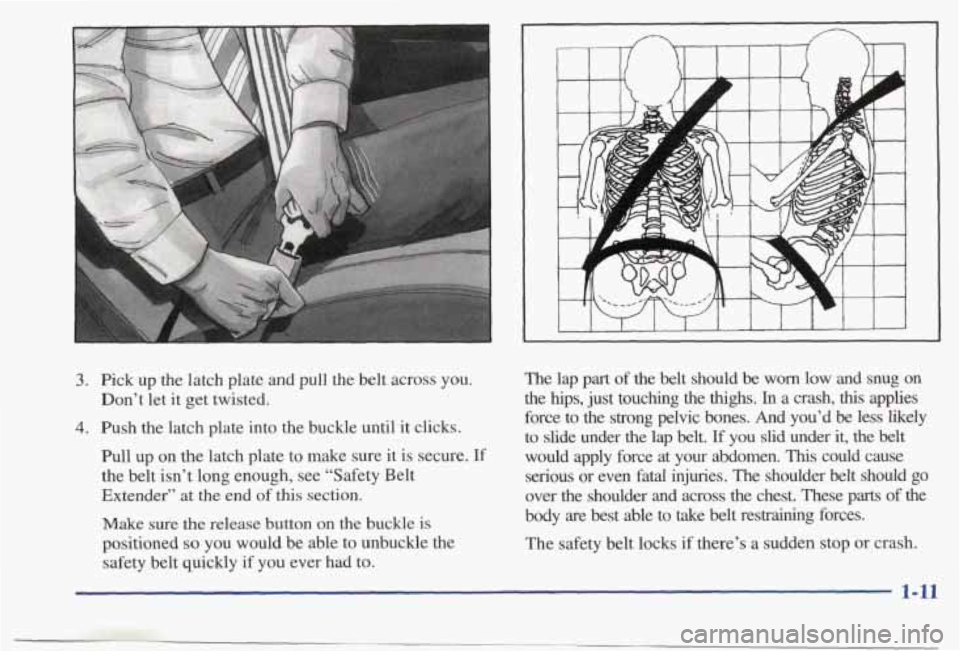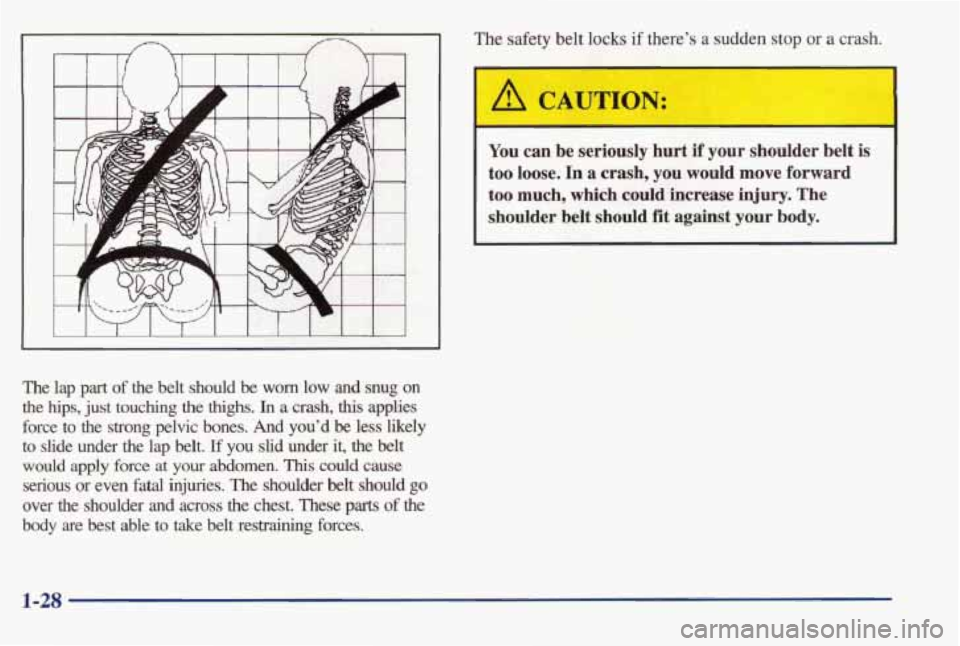lock PONTIAC BONNEVILLE 1998 Owners Manual
[x] Cancel search | Manufacturer: PONTIAC, Model Year: 1998, Model line: BONNEVILLE, Model: PONTIAC BONNEVILLE 1998Pages: 395, PDF Size: 17.6 MB
Page 6 of 395

Vehicle Symbols
These are some of the symbols you may find on your vehicle.
For example,
these symbols are used on an
original battery:
POSSIBLE A
CAUTION
INJURY
PROTECT EYES BY
SHIELDING
Q
CAUSTIC
ACID COULD BAllERY
CAUSE -~~-. .
BURNS
AVOID
SPARKS
OR
FLAMES
SPARK
OR ,\I/,
COULD FLAME
EXPLODE BAllERY
I
These symbols are important
for you and
your passengers
whenever your
vehicle is
driven:
DOOR LOCK
UNLOCK
n
POWER
WINDOW
oJ4
AIR BAG p
These symbols
have to do with your lamps:
SIGNALS e3
TURN
FOG LAMPS
# 0
These symbols are on some
of
your controls:
WINDSHIELD
WIPER
WINDSHIELD
DEFROSTER
DEFOGGER
VENTILATING FAN
( rc?: A
These symbols are used on
warning
and
indicator lights:
COOLANT -
TEMP -
CHARGING I-1
BAllERY
SYSTEM
BRAKE
(a)
R
Here are some
other symbols
you may see:
FUSE
LIGHTER
n
HORN )b.
ENGINE OIL e,
PRESSURE
V
SPEAKER
b
FUEL
Page 9 of 395

Seats and Seat Controls
This section tells you about the seats -- how to
adjust them
-- and also about reclining seatbacks
and head restraints.
Manual Front Seat
A CAUTION:
You can lose control of the vehicle if you try to
adjust a manual driver’s seat while the vehicle is
moving. The sudden movement could startle and
confuse
you, or make you push a pedal when you
don’t want to. Adjust the driver’s seat
only when
the vehicle
is not moving.
Pull
up on the control bar under the front of the seat to
unlock it. Slide the seat to where you want it. Then
release the bar and
try to move the seat with your body,
to make sure the seat is locked into place.
Power Seat (Option)
To adjust the power seats on
some models:
Front Control
(A): Raise the front of the seat by
holding the switch up. Lower the front of the seat by
holding the switch down.
Center Control
(B): Move the seat forward by pressing
the control forward, or backward by pressing the
control backward.
Move the seat higher by holding the control up. Lower
the seat by holding the control down.
Rear Control (C): Raise the rear
of the seat by holding
the switch up. Lower the rear of the seat by holding the
switch down.
1-2
Page 10 of 395

Power Lumbar Controls (Option)
d? Reshapes the lower back area of the seat.
d Reshapes the middle back area of the seat.
Reshapes the upper back area of the seat.
Adjustable Support Seat (Option)
& Adjusts the position of the seatback side bolsters.
'd Tilts the rear of the seat up or down.
A& Tilts the front of the seat up or down.
Reclining Front Seatbacks
On some models, you'll
find the controls on the center console. Slide the
selector switch to
L or R to
choose the front seat you
want to adjust.
4 d!. Adjusts the seat forward or back.
d Adjusts the seat up or down.
&' Adjusts the seatback to an upright or
reclined position.
To adjust the seatback, lift the lever on the outer side of
the seat and move the seatback to where you want it.
Release the lever to lock the seatback.
PuII up on the
lever and the seat
will go to an upright position.
1-3
Page 17 of 395

Q: If I’m a good driver, and I never drive far from
home, why should I wear safety belts?
A: You may be an excellent driver, but if you’re in an
accident -- even one that isn’t your fault -- you and
your passengers can be hurt. Being a good driver
doesn’t protect you from things beyond
your
control, such as bad drivers.
Most accidents occur within
25 miles (40 km) of
home. And the greatest number
of serious injuries
and deaths occur at speeds
of less than 40 mph
(65 km/h).
Safety belts are for everyone.
How to Wear Safety Belts Properly
Adults
This part is only for people of adult size.
Be aware that there are special things to know about safety
belts and children. And there are different rules for smaller
children and babies.
If a child will be riding in your
vehicle, see the part of this mand called “Children.”
Follow those rules for everyone’s protection.
First, you’ll want to know which restraint systems your
vehicle has.
We’ll start with the driver position.
Driver Position
This part describes the driver’s restraint system.
Lap-Shoulder Belt
The driver has a lap-shoulder belt. Here’s how to wear
it properly.
1. Close and lock the door.
2. Adjust the seat (to see how, see “Seats” in the Index)
so you can sit up straight.
1-10 - .
Page 18 of 395

“ .”. .. -.
3. Pick up the latch plate and pull the belt across you.
4. Push the latch plate into the buckle until it clicks.
Don’t let
it get twisted.
Pull up on the latch plate to make sure it
is secure. If
the belt isn’t long enough, see “Safety Belt
Extender” at the end
of this section.
Make sure the release button on the buckle is
positioned
so you would be able to unbuckle the
safety belt quickly
if you ever had to. The lap part of the belt should
be worn low and snug on
the hips, just touching the
thighs. In a crash, this applies
force to the strong pelvic bones.
And you’d be less likely
to slide under the lap
belt. If you slid under it, the belt
would apply force at your abdomen.
This could cause
serious or even fatal injuries. The shoulder belt
should go
over the shoulder and across the chest. These parts of the
body are best able to take belt restraining forces.
The safety belt locks if there’s a sudden stop or crash.
1-11
Page 19 of 395

Shoulder Belt Height Adjuster
Before you begin to drive, move the shoulder belt
adjuster to the height that is right
for you.
To move it down, squeeze the release handle and move
the height adjuster to the desired position. You can move
the adjuster up just
by pushing up on the bottom of the
release handle. After you move the adjuster to where
you
want it, try to move it down without squeezing the
release handle to make sure it has locked into position.
Adjust the height so that the shoulder portion of the belt is
centered on your shoulder. The belt should be away from
your face and neck, but not falling off your shoulder.
1-12
Page 25 of 395

The best way to protect the fetus is to protect the
mother. When a safety belt is
worn properly, it’s more
likely that the fetus won’t be hurt in a crash. For
pregnant women, as for anyone, the key to making
safety belts effective is wearing them properly.
Right Front Passenger Position
To learn how to wear the right front passenger’s safety belt
properly,
see “Driver Position’’ earlier in this section.
The right fiont passenger’s safety belt works the same way
as
the driver’s safety belt -- except for one thing. If you ever pull
the lap portion of the belt out
all the way, you will engage the
child restraint locking feature. If this happens, just let the belt
go back all the way and start again.
If your vehicle has a center passenger position, be sure
to use the correct buckle when buckling your
lap-shoulder belt.
If you find that the latch plate will not
go fully into the buckle, see if you are using the buckle
for the center passenger position.
Supplemental Restraint System (SRS)
This part explains the Supplemental Restraint System
(SRS) or air bag system.
Your vehicle has “Next Generation” reduced-force
frontal air bags
-- one air bag for the driver and another
air bag for the right front passenger. Reduced-force frontal
air bags
are designed to help
reduce the
risk of injury from the force of an inflating
frontal
air bag. But even these air bags must inflate very
quickly
if they are to do their job and comply with
federal regulations.
Here are
the most important things to know about the air
bag system:
I
pu can be severely injured or killed in a crash if
you aren’t wearing your safety belt -- even if you
have
air bags. Wearing your safety belt during a
crash helps reduce your chance of hitting things
inside the vehicle or being ejected from it. Air bags
are “supplemental restraints” to the safety belts.
All air bags -- even redud-force air bags -- are
designed to work with safety belts, but don’t
replace them. Air bags ace designed to work only
in moderate to severe crashes where the front of
your vehicle hits something. They aren’t designed
to Mate at all in rollover, rear, side or low-speed
CAUTION: (Continued)
Page 35 of 395

The lap part of the belt should be worn low and snug on
the hips, just touching the thighs. In a crash, this applies
force to the strong pelvic bones. And you’d be less likely
to slide under the lap belt. If you slid under it, the belt
would apply force at your abdomen. This could cause
serious or even fatal injuries. The shoulder belt should go
over the shoulder and across the chest. These parts of the
body are
best able to take belt restraining forces.
The safety belt locks if there’s a sudden stop or a crash.
I
You can be seriously hurt if your shoulder belt is
too loose. In a crash, you would move forward
too much, which could increase injury. The
shoulder
belt should fit against your body.
I
1-28
Page 52 of 395

A
A
4. Buckle the belt. Make sure the release button is
positioned so you would be able to unbuckle the
safety belt quickly if you ever had to.
5. Pull the rest of the lap belt all the way out of the
retractor to set the lock.
1-45
Page 58 of 395

Section 2 Features and Controls
Here you can learn about the many standard and optional featur\
es on your vehicle, and information on starting,
shifting and braking.
Also explained are the instrument panel and the warning systems that tell you if everything is
working properly
-- and what to do if you have a problem.
2-2
2-4 2-
10
2- 14
2-15
2-16
2-18
2- 19
2-20
2-21
2-23
2-24
2-28
2-29 2-32
2-33 2-33 Keys
Door Locks
Remote Keyless Entry (Option)
TnXnk
Theft
Universal Theft-Deterrent (Option)
PASS-Key@
I1
New Vehicle “Break-In”
Ignition Positions
Starting
Your Engine
Engine Coolant Heater (If Equipped) Automatic Transaxle Operation
Computer Command Ride (Option)
Shifting Into PARK (P)
Shifting Out
of PARK (P)
Parking Over Things That Burn Engine Exhaust 2-34
2-35
2-35
2-36
2-36
2-43
2-46
2-48 2-5
1
2-53
2-54
2-55
2-56 2-62
2-74
2-77
2-79 Running
Your Engine While You’re Parked
Windows Horn
Tilt Wheel
Turn SignaYMultifunction Lever
Exterior Lamps
Interior Lamps
Mirrors Storage Compartments
Sun Visors
Air Inflator System (Option)
Sunroof (Option)
Instrument Panel
Warning Lights, Gages and Indicators Head-Up Display (Option)
Driver Information Center (Option)
Electronic Compass (Option)
2-1